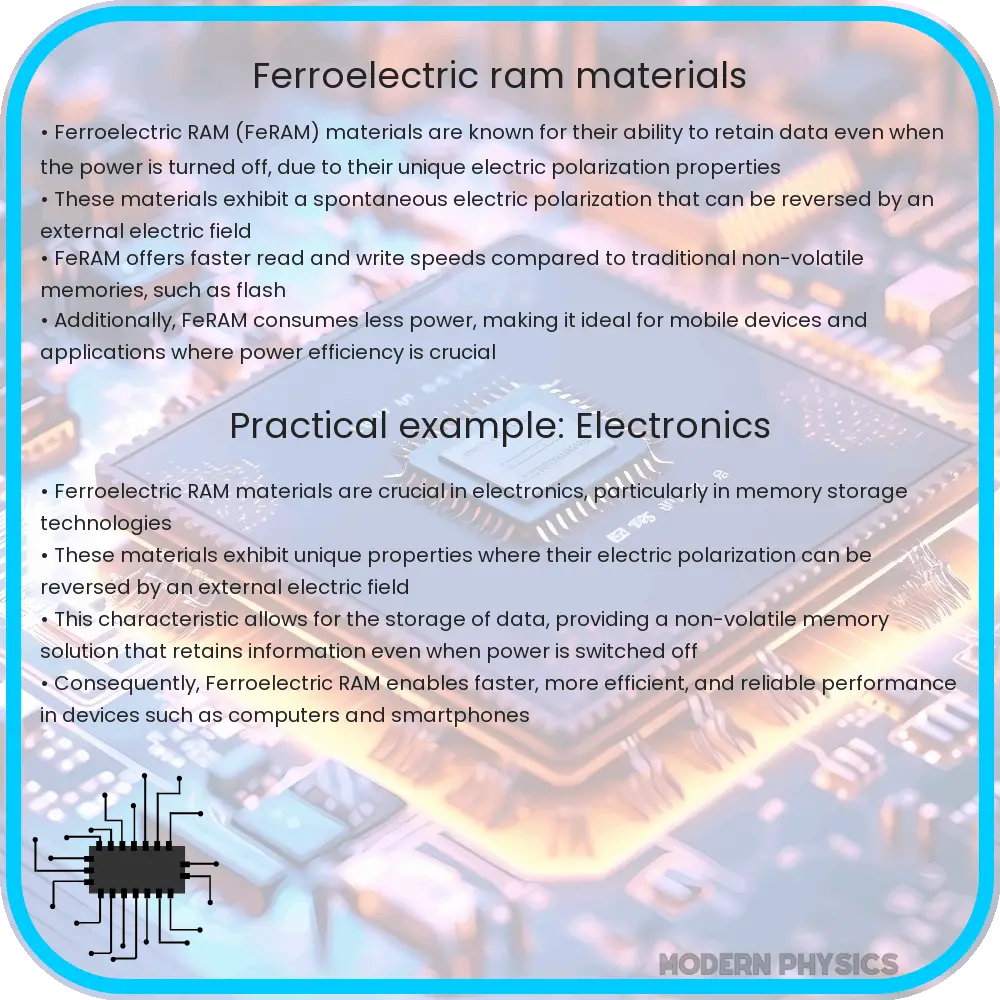Learn about Ferroelectric RAM (FRAM), a memory technology that combines speed, durability, and energy efficiency, utilizing unique ferroelectric materials.

Understanding Ferroelectric RAM: Materials, Durability, Efficiency, and Speed
Ferroelectric Random-Access Memory (FeRAM or FRAM) has emerged as a fascinating alternative to traditional RAM technologies due to its unique combination of speed, durability, and energy efficiency. Understanding the science behind this technology starts with the ferroelectric materials that grant FRAM its distinctive attributes.
What Makes a Material Ferroelectric?
Ferroelectric materials are crystals that exhibit a spontaneous electric polarization that can be reversed by the application of an external electric field. This property stems from their non-centrosymmetric crystal structure, typically of the perovskite type. The most commonly used ferroelectric material in FRAM is Lead Zirconate Titanate (PZT), which is known for its robust ferroelectric properties.
Advantages of Ferroelectric RAM Materials
- Non-volatility: Like flash memory, FRAM retains its data when power is switched off. This is crucial for applications that require data persistence without continuous power consumption.
- Speed: FRAM can achieve read and write speeds comparable to those of conventional RAM. This is primarily due to the inherent nature of the ferroelectric material, which allows quick polarization switching — on the orders of nanoseconds.
- Endurance: FRAM provides significantly higher read/write cycles compared to NAND flash memory—up to 1012 cycles. This is an essential attribute for systems where memory is frequently accessed and rewritten.
- Energy Efficiency: FRAM consumes less power during write operations than traditional RAM, making it ideal for mobile devices and embedded systems where power consumption is a critical factor.
Ferroelectric Materials: Key to Durability and Efficiency
At the heart of FRAM’s durability and efficiency is the robustness of ferroelectric materials like PZT. Their unique crystalline structure allows them to undergo polarization switching without significant degradation. This switching is the fundamental mechanism for storing data. The efficiency of this process, in terms of both energy consumption and speed, relies significantly on the inherent properties of the ferroelectric material used.
The durability of ferroelectric materials in FRAM is related to their ability to handle high amounts of read and write cycles. Unlike flash memory, which degrades due to the physical wear of charge trapping and detraping over cycles, ferroelectric materials face no such fundamental wear mechanisms, considerably extending the lifetime of FRAM devices.
Speed: A Core Asset of Ferroelectric RAM
The speed at which FRAM operates can rival that of traditional DRAM, all the while providing non-volatile storage capabilities. The switching of the polarization state is rapid and can be accomplished in nanoseconds; hence, the access times for FRAM are significantly lower than those for flash memory. Such quick data transactions make FRAM suitable for a range of applications, from mainstream computing to critical real-time systems.
By overcoming the trade-offs between speed, durability, and power efficiency found in other types of memory, ferroelectric RAM stands out as a promising technology for future memory storage solutions.
Applications and Future Perspectives of Ferroelectric RAM
The potential applications of Ferroelectric RAM are vast and varied. From consumer electronics, such as smartphones and tablets, to more critical applications in aerospace and automotive systems, FRAM’s reliability and speed offer considerable advantages. In healthcare, for instance, devices that require quick access to large amounts of data while maintaining data integrity—like portable patient monitors—can benefit greatly from FRAM technology.
As technological advancements continue, the scalability of FRAM might see improvements that could lead to its more widespread adoption. Research is ongoing in exploring lead-free ferroelectric materials, addressing environmental concerns related to lead-based materials like PZT. Furthermore, improvements in fabrication techniques may further enhance the density and performance of FRAM, making it even more competitive with existing memory technologies.
Challenges in Ferroelectric RAM Development
Despite its numerous benefits, FRAM faces some challenges in widespread implementation. The production cost, driven by the complexity of fabricating high-quality ferroelectric materials and integrating them into existing manufacturing processes, still remains a significant barrier. Additionally, while lead-based ferroelectric materials are effective, they pose environmental and health risks, prompting a need for the development of safer alternatives. Addressing these challenges is crucial for the future growth of FRAM technologies.
In conclusion, Ferroelectric RAM represents a significant advancement in the field of memory storage, characterized by its speed, endurance, and energy efficiency. Although challenges remain, ongoing research and development are likely to address these and expand the practical applications of this promising technology. By continuously improving material properties and fabrication techniques, the future of FRAM looks bright, promising a new era of efficient, fast, and durable memory storage solutions.
